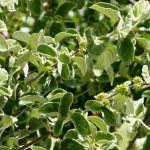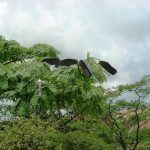TREE LIFE
July 2007
MASHONALAND CALENDAR
List of outings distributed separately.
MATABELELAND CALENDAR
Please contact Jean Wiley or Gill Short for details of the next Matabeleland function.
EDITOR’S NOTE
Mark Hyde and I have experienced a few minor glitches, due mainly to space and technology, in making the transition in the editor’s role, hence the separate distribution of the outings list this month.
We intend to achieve a more normal distribution schedule for the August edition.
Bill Kinsey
HAKA GAME PARK, CLEVELAND DAM: 15 APRIL 2007
A slightly slow start to this outing. Terry Fallon and I were the first to arrive and it was not until nearly 9.30 a.m. that the next batch of people began arriving at the assembly point and it was a little while after that before we got started.
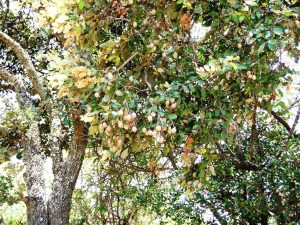
Parinari curatellifolia. Photo: Rob Burrett. Source: Flora of Zimbabwe
We assembled at an area set aside for picnics and braais within a grove of trees, largely Parinari curatellifolia. This is not far from the entrance and also not far from the fence separating Haka from the municipal area of Cleveland Dam.
Although I have visited it personally from time to time in recent years it has been some time since the Tree Society visited Haka. Basically, Haka Game Park covers the higher parts of the Cleveland Dam catchment area. Wide vleis which become streams and eventually the upper arms of the dam itself form a large part of the Park. Here and there are patches of miombo woodland on sandy soils with some granite rocks and small hills adding variety to the flora.
The altitude is quite high (c. 1550 m (5,100 feet) at the braai site) and a little higher still where we walked.
We set off in convoy to a distant patch of woodland, near where, earlier, Terry and I had seen a giraffe. Very kindly, Meg Coates Palgrave agreed to lead the outing, which was a great treat for me as I could then concentrate on recording plants. We parked in the woodland amongst the rocky kopjes.
The first tree examined was a small epiphytic Ficus burkei growing in a bulge of a tree trunk a little way off the ground. We have all had to re-think these species of the ‘Ficus thonningii complex’ a bit lately as a result of work done by John Burrows. However, the new treatment does make a lot more sense than the earlier one in which a lot of different entities were submerged within Ficus thonningii.
Meg pointed out that in this species the petiole looks as if it has been stuck on to the lamina. Furthermore, this species is not 3-veined from the base as many figs are. It is a common species around Harare, which we see frequently on our outings.
Nearby was an epiphytic orchid, Tridactyle tridentata. This semi-succulent species has leaves which are more or less round in cross-section (terete) and one of its former names is Tridactyle teretifolia –an easily memorable name. It seems to be a fairly frequent species in miombo woodland, especially in areas of locally higher rainfall.
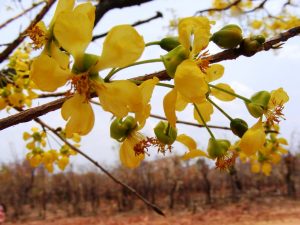
Ochna schweinfurthiana. Photo; Mike Bingham. Source: Flora of Zimbabwe
Ochna schweinfurthiana (the Brick-red Ochna) was the next tree examined. Meg mentioned a belief that if you chop down one of these trees there will be a divorce in the family. Someone wittily suggested that it was therefore all right for unmarried people to cut them down. Ochnas are well known for their short-lived but intense flowering period; this may occur over a period of 2 days, there then may be no activity for a week and then active flowering for a further 2 days and so on.
The bark is rough with marked horizontal ridges and is slightly rusty-coloured underneath. Meg mentioned that it is like Brackenridgea (another genus in the Ochnaceae) but that genus is more rusty.
Nearby was a small Ochna puberula up against a rock face. This is usually readily distinguished by always growing in rocky places and in the relatively small leaves compared to O. schweinfurthiana and O. pulchra.
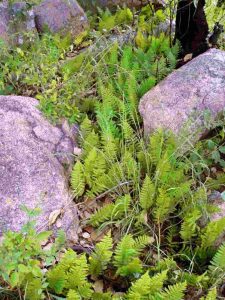
Arthropteris orientalis. Photo: Mark Hyde. Source: Flora of Zimbabwe
Throughout the woodland in great abundance was the Msasa fern, Arthropteris orientalis. This forms great patches of green fronds in summer and these turn brown and may wither away completely in the dry season. It is a very common and characteristic species of our woodland.
Other species seen at this point included Rhus longipes, Ozoroa reticulata, Parinari curatellifolia, Lantana camara (as always!), Msasa and the aromatic herb Lippia javanica.
Also here was the knee-high suffrutex, Grewia decemovulata. Meg explained how these suffrutices are really underground trees with huge underground woody stems. This has simple leaves, harsh to the touch, and 3-veined from the base. Unlike many other grewias this has a fairly symmetrical base.
We then entered a more open area of woodland with low rocky outcrops and on one of these we came across Pavetta gardeniifolia. Known as the Stink-leaf bride’s bush, it does indeed have a strongly foetid leaf – much more so than the other common Pavetta, P. schumanniana. Meg pointed out that its style of branching, namely of rosettes borne on bare branches which curve upwards is similar to that of many Terminalia species. (A number of other tree species also possess this feature – notably the Sapotaceae – a species like Manilkara mochisia particularly).
In this more open area, we came across various weeds. In particular, the Silverleaf, Desmodium uncinatum, a serious and ubiquitous invader. The same words also well describe the Crofton weed, Ageratina adenophora. No Tree Society outing these days passes without us encountering these two aliens.
After a short walk through some grassland, we entered some open woodland with plenty of light which meant quite a thick grassy understorey. Here we came across an interesting herb, Wahlenbergia capitata. Wahlenbergias are bellflowers, related to the genus Campanula (from which the bell concept comes), This particular species has blue flowers in heads (this is the implication of the specific name). Meg very kindly took some pictures of this and these may be found on the Flora of Zimbabwe web site.
Another little species we saw at the time and whose name proved elusive was Oxalis obliquifolia. The flowers are solitary on the stems – whereas in most Oxalis species they are borne in a false umbel.
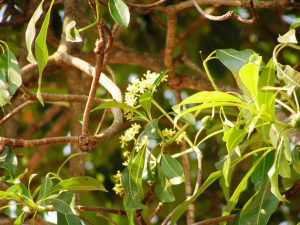
Rauvolfia caffra. Photo: Jos Stevens. Source: Flora of Zimbabwe
By now, stomachs were rumbling and we turned back to the cars. On the way, we encountered a specimen of Rauvolfia caffra, the Quinine tree. Was it there naturally or is it being spread around the Harare area by birds from the numerous planted specimens? We discussed this issue and were able to examine its whorled leaves with their milky sap.
We then drove back to the braai area for lunch.
In the afternoon a small group of keen people had a short walk in the immediate vicinity. This turned out to be quite interesting as many of the trees were different from the morning’s walk. In particular, we saw Protea gaguedi, Swartzia madagascariensis, Monotes engleri and a number of others.
All in all, it was a very pleasant day in a very convenient, close location, with much of interest to see. We intend a return visit, perhaps at a different season.
-Mark Hyde
Trees as habitats. [Ed: This article, adapted from the June 2007 VeId & Flora, describes the South African wild almond and its unique load of passengers. It would be interesting to learn if anyone knows of such communities of associated species in Zimbabwe.]
Part 1
The wild almond tree, Brabejum stellatifolium, made its mark in the early days of the Cape Colony when its fruit, albeit somewhat toxic, was used as a coffee substitute. Although called almond, it isn’t one. The almond, Prunus dulcis, belongs in the rose family. On the other hand, the search for the relatives of Brabejum has been long and not entirely straightforward. The genus was described by Linnaeus himself, and from early on it was clear that it belonged to the protea family, yet it did not fit in very closely with the other South African Proteaceae. The family Proteaceae comprises several subfamilies, two of which contain the vast majority of the species. The Proteoideae, that includes all South African Proteaceae besides Brabejum, also contain a diverse range of Australian taxa. The other subfamily, Grevilleoideae, is mostly Australasian, but also includes several South American, and a single South African species: the wild almond. The closest of the wild almond relatives appears to be a genus called Panopsis, found in swamps in tropical America. Also close to Brabejum, and certainly more familiar, is the genus Macadamia, which produces the edible nuts, and is distributed in Australasia.
So how did the wild almond land in the Cape? The traditional explanation would be that both Proteoideae and Grevilleoideae were already in existence before the split of Gondwanaland, and that both lineages diversified on either of the resulting landmasses. While Australia saw explosive radiations in both cases, in Africa only the Proteoideae became diverse. The Grevilleoideae stayed as one species, or if any diversification occurred, only one of the resulting lineages made it to the present day. That would mean the wild almond has been separated from its closest relatives for some one hundred million years!
An alternative explanation would be that there were no Grevilleoideae in Africa to start with, and the wild almond literally landed here as a fruit or propagule of some sort, crossing the oceans all the way from South America or Australia, some time after the continents parted ways. This dispersal event would have had to be rather ancient in either case, so the wild almond tree must have been lining the Cape rivers for quite some time, while all around it forests turned to shrub lands, and deserts, ice shelves and new ocean currents were re-drawing the distribution of most life forms on earth. But it wasn’t alone. Several interesting organisms kept it company, associated with it and no other plant. Some of them are not very conspicuous, but may prove to be quite important in the greater scheme of things. To start with, a range of characteristic fungi have been described from Brabejum, such as Anthostomella brabeji, Phyllosticta owaniana and Harknessia capensis. Harknessia also occurs on eucalypts in the Jonkershoek Valley in South Africa, although it has been found on no other indigenous plant. This suggests that there has been a recent transition from the wild almond to this secondary, alien host. There is a chance the fungus may in the long run slow down the eucalypts’ invasion rate, and this highlights the importance of indigenous plants as reservoirs of potential control agents for aliens.
More conspicuous are the galls of a minute mite species, Aceria rusti (Eriophyidae), barely measuring 0.2 mm. However, it is often impossible to detect the mites in the most obvious galls. The reason for this is that mite activity is characteristic to a certain phase in the development of leaves and shoots, when they induce gall appearance and development, and feed there for a while. After that they move on, but the galls keep on growing, becoming more and more obvious. But how do mites disperse from one tree to another, in environments dominated by other plants that cannot offer them a home and a meal? Nobody knows for sure how Aceria rusti does it, but a suggestion comes from other eriophyid mite species. These have been found moving from one plant to another on the backs of slightly larger herbivores, which have the advantage of being able to fly.
And this brings up other Brabejum associates: two species of apionid weevils — Setapion provinciale and S. quantillum. Both species are widely distributed in the Cape, occurring virtually everywhere the wild almonds grow. However, for most of the year you are likely to see only S. quantiflum, the lesser species, found in large numbers on the leaves. S. proviaciale appears only seasonally, and is associated with the terminal buds that will ultimately develop into flowerheads. The Setapion brotherhood has a special place in the weevil picture. They belong in the Tanaonini, an African endemic group of Apionidae, most of which are associated with Proteaceae. They may be true ‘living fossils’, from the days when advanced weevils had not yet reached Africa. Nowadays, proteas have several other weevil associates, as is often the case: distantly related species can co-exist on one plant, filling different niches. It is more seldom that closely related species co-occur.
To be continued


